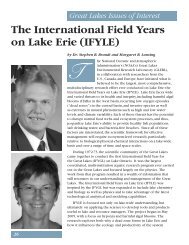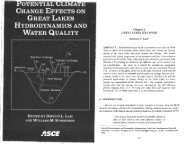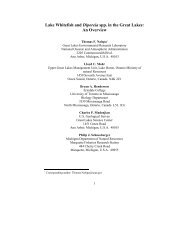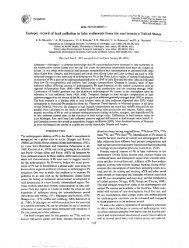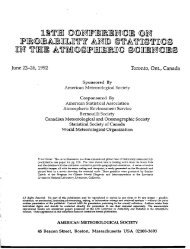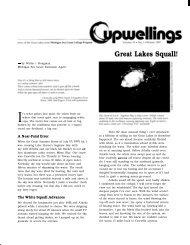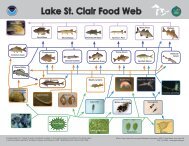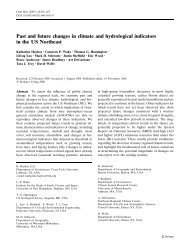CHAPRA, STEVEN C. Applying phosphorus loading ... - GLERL
CHAPRA, STEVEN C. Applying phosphorus loading ... - GLERL
CHAPRA, STEVEN C. Applying phosphorus loading ... - GLERL
You also want an ePaper? Increase the reach of your titles
YUMPU automatically turns print PDFs into web optimized ePapers that Google loves.
nevertheless suggests the greater accu-<br />
racy to be achieved by duplicate deter-<br />
minations.<br />
While the values of the variability of<br />
temperature and salinity of the mixed<br />
layer are similar to those of the corre-<br />
sponding accuracies of measurement, the<br />
value for oxyty is almost twice as large<br />
(Table 3) as is indicated by the precision<br />
of the measurements. It is unlikely that<br />
biological activity in the layer could<br />
cause the oxyty to vary much. It is more<br />
likely that the larger variability has re-<br />
sulted from sampling errors. Even if the<br />
actual titration is carried out properly,<br />
errors could arise from a number of other<br />
sources, such as the condition of the in-<br />
terior of the hydrographic sampling bot-<br />
tles (which might be such as to promote<br />
oxidation), air introduced into the BOD<br />
bottles while the samples are drawn, and<br />
undue delay in adding reagents. There is<br />
no apparent reason why the variability of<br />
oxyty could not be reduced if proper pro-<br />
cedures are followed during sampling<br />
and determination. The data so far ob-<br />
tained indicate that the layer is iso-oxy-<br />
genie only to within 20.04 to ~0.05<br />
ml. liter-l (Table 3). However, if we<br />
adopt the values resulting from duplicate<br />
Limnol. Oceanogr., 24(l), 1979, 163-168<br />
@ 1979, by the American Society of Limnology and Oceanography, Inc.<br />
Notes 163<br />
determinations, it appears that the mixed<br />
layer can be considered iso-oxygenic to<br />
within to.03 ml* liter-’ (Table 4)-a val-<br />
ue close to the precision of the instru-<br />
mentation.<br />
Institute of Ocean Sciences<br />
Patricia Bay<br />
Sidney, British Columbia V8L 4B2<br />
References<br />
<strong>Applying</strong> <strong>phosphorus</strong> <strong>loading</strong> models to embayments’<br />
Abstract-An explicit turbulent mass trans-<br />
port term is added to a <strong>phosphorus</strong> budget<br />
model to make it applicable to completely<br />
mixed water bodies with open boundaries; an<br />
application to Saginaw Bay demonstrates the<br />
importance of this modification. A method is<br />
devised to incorporate turbulent diffusion into<br />
<strong>loading</strong> plots by adjusting the <strong>loading</strong> term to<br />
include the flux of <strong>phosphorus</strong> from the main<br />
lake into the bay and including the effect of<br />
turbulent flow in the residence time.<br />
Vollenweider, Dillon, and others have<br />
developed a general approach for pre-<br />
l <strong>GLERL</strong> contribution 133.<br />
S. Tabata<br />
BROWN, N. L., AND B. V. HAMON. 1961. An induc-<br />
tive salinometer. Deep-Sea Res. 8: 65-75.<br />
CARPENTER, J. H. 1965u. The accuracy of the<br />
Winkler method for dissolved oxygen analysis.<br />
Limnol. Oceanogr. 10: 135-140.<br />
-. 1965b. The Chesapeake Bay Institute tech-<br />
nique for the Winkler dissolved oxygen meth-<br />
od. Limnol. Oceanogr. 10: 141-143.<br />
STRICKLAND, J. D. 1958. Standard methods of sea-<br />
water analyses, v. 2. Fish. Res. Bd. Can. Ms.<br />
Rep. Ser. Oceanogr. Limnol. 19. 78 p.<br />
-, AND T. R. PARSONS. 1968. A practical hand-<br />
book of seawater analysis. Bull. Fish. Res. Bd.<br />
Can. 167.<br />
TABATA, S. 1965. Variability of oceanographic con-<br />
ditions at Ocean Station “P” in the northeast<br />
Pacific Ocean. Trans. R. Sot. Can. Ser. 4 Sec.<br />
3, p. 367418.<br />
Submitted: 21 February 1978<br />
Accepted: 5 July 1978<br />
dieting a lake’s trophic state on the basis<br />
of simple expressions of its nutrient load-<br />
ing, morphology, and hydrology. The<br />
best known examples are <strong>phosphorus</strong><br />
<strong>loading</strong> plots (Vollenweider 1968, 1975),<br />
which have found wide application in<br />
eutrophication analysis. Other expres-<br />
sions of the approach are nutrient budget<br />
models that parameterize some of the<br />
mechanisms underlying the process (Vol-<br />
lenweider 1969; Dillon and Rigler 1974;<br />
Chapra 1977). In most cases, the analyses<br />
have been of lakes where advection<br />
through river outlets is the predominant<br />
form of mass transport out of the system.
164 Notes<br />
However, there is a large class of waters,<br />
namely embayments, where turbulent or<br />
diffusive transport is of considerable im-<br />
portance. For example, two of the most<br />
degraded water bodies in the Great<br />
Lakes are Saginaw Bay and Green Bay,<br />
which have large open boundaries with<br />
Lakes Huron and Michigan. I here de-<br />
velop a simple model for those bays that<br />
can be considered as completely mixed<br />
systems when a term for turbulent mass<br />
transport is added to a nutrient budget<br />
equation. The model is applied to Sagi-<br />
naw Bay where the importance of this<br />
term is demonstrated. A method of incor-<br />
porating such effects into <strong>loading</strong> plots is<br />
also presented.<br />
I thank V. J. Bierman, D. M. Dolan, A.<br />
Pinsak, W. Rast, K. H. Reckhow, W. C.<br />
Sonzogni, R. V. Thomann, and R. A. Vol-<br />
lenweider for comments and suggestions.<br />
A nutrient budget model for total phos-<br />
phorus (Vollenweider 1969, as modified<br />
by Chapra 1975) can be written for the<br />
completely mixed lake in Fig. la as<br />
dp<br />
Vz= W + 2 Qipi - Qp - VAsp,<br />
i=l<br />
(1)<br />
where V is volume of the lake, p is total<br />
<strong>phosphorus</strong> concentration of the lake, t<br />
is time, W is direct mass <strong>loading</strong> of total<br />
<strong>phosphorus</strong> to the lake, Qi is flow of<br />
water into the lake from the ith tributary,<br />
pi is the concentration of total phospho-<br />
rus in the ith tributary, n is the total num-<br />
ber of tributaries, Q is flow through the<br />
lake’s outlet = the summation of all trib-<br />
utary flows if evaporation equals precip-<br />
itation and the lake’s volume is constant,<br />
v is the apparent settling velocity of total<br />
<strong>phosphorus</strong>, and A, is the surface area of<br />
the lake’s sediments. By grouping terms<br />
and assuming a steady state (dpldt = 0),<br />
we can solve Eq. 1 for total <strong>phosphorus</strong><br />
concentration,<br />
‘= ,:;A,’<br />
where W’ is the total <strong>loading</strong> to the lake =<br />
(2)<br />
however, an additional term must be<br />
added to Eq. 1 to account for the turbu-<br />
lent mass transport or mixing across the<br />
open boundary. Thomann (1963) has pa-<br />
rameterized such transport as<br />
&<br />
( %t ><br />
diffusion<br />
= UP, - PL (3)<br />
where pb is the concentration of phos-<br />
phorus in the main lake; E’ is the bulk<br />
diffusion coefficient, expressed as<br />
El - EAc<br />
1<br />
(4)<br />
(E is a turbulent diffusion coefficient, A,<br />
is the cross-sectional area at the interface<br />
between the bay and the main lake, and<br />
1 is the mixing length of the exchange<br />
process). Equation 3 is similar in concept<br />
to the tidal prism method (Phelps and<br />
Velz 1933; Ketchum 1950) designed to<br />
model flushing in salt water river estuaries<br />
where tidal oscillations are the predominant<br />
cause of turbulent exchange. In<br />
freshwater systems, seiches and transient<br />
currents would have an analogous effect<br />
of minimizing gradients and therefore<br />
causing mass transport between an embayment<br />
and a main lake. In fact, many<br />
investigators have used the method to<br />
estimate flushing times and the diffusion<br />
characteristics of freshwater bays (e.g.<br />
Beeton et al. 1967; Ahrnsbrak and Ragotzkie<br />
1970). In the present context Eq.<br />
1 and 3 can be combined to yield a nutrient<br />
budget equation for the idealized<br />
bay in Fig. lb:<br />
n<br />
dP<br />
Vz= W + ,z QiPi - QP - VAsP<br />
+ E’(P~ - P>; (5)<br />
which, at steady state can be solved for<br />
where<br />
’ = Q + vy + E”<br />
(6)<br />
W” = W + 2 Qipi + E’pb. (7)<br />
For systems having open boundaries Thus, the total <strong>loading</strong> to the bay system,<br />
with adjacent water bodies (Fig. lb), W”, includes the <strong>loading</strong> due to turbulent<br />
i=l
(a) W<br />
Fig. 1. Schematic overhead views of a lake (a)<br />
and an embayment (b) showing a waste input<br />
(--+), advective mass transport (+), and turbulent<br />
or diffusive mass transport (tt).<br />
mixing from the main lake into the bay as<br />
well as tributary and direct inputs.<br />
The bulk diffusion coefficient can be<br />
estimated theoretically or empirically. In<br />
the former case, this often involves the<br />
aggregation of current velocities calculat-<br />
ed by numerical hydrodynamic models<br />
(Canale and Squire 1976). More com-<br />
monly, where a sufficient gradient exists<br />
between the bay and the main lake, con-<br />
servative substances such as chlorides<br />
can be used to estimate E’ empirically<br />
(Ahrnsbrak and Ragotzkie 1970; Richard-<br />
son 1976). Th is is done by writing a mass<br />
balance equation for the conservative<br />
substance as<br />
V 2 = WC + 2 Qici - QC + E’(Cb - C),<br />
i=l<br />
03)<br />
where c is the concentration of conser-<br />
vative substance in the bay, W, is the di-<br />
rect <strong>loading</strong> of conservative substance to<br />
the bay, ci is the conservative substance<br />
concentration of the ith tributary, and cb<br />
is the conservative substance concentra-<br />
tion of the main lake. At steady state, Eq.<br />
8 can be solved for<br />
Et =Wc + CQtci - QC<br />
Notes 165<br />
(9)<br />
Direct Loading<br />
Data for the system from 1974 through<br />
1976 are summarized in Table 1. Substi-<br />
tuting the appropriate values into Eq. 9<br />
yields a bulk diffusion coefficient of<br />
25.1 km3* yr-l. This can be expressed in<br />
the more familiar context of a turbulent<br />
diffusion coefficient by using Eq. 4. The<br />
resulting diffusion coefficient of about<br />
5 X lo5 cm2 * s-l is generally of the order<br />
of horizontal diffusion coefficients for<br />
this scale of motion (Boyce 1974).<br />
c - cb<br />
An application of Eq. 6 and 9 to an ac- To calculate total <strong>phosphorus</strong> concentual<br />
system can be demonstrated for Sag- tration, an estimate of the apparent setinaw<br />
Bay, a freshwater embayment in tling velocity is required. Dillon (pers.<br />
southwestern Lake Huron (Fig. 2). comm.) has suggested a value of 12.4<br />
Chemical data were used to situate the rn. yr-‘, based on a least-squares fit of<br />
interface between the bay and Lake Hu- <strong>phosphorus</strong> budget data from a large<br />
i<br />
LAKE<br />
Loss to sediments<br />
SCALE (KIlometers)<br />
(1241) :, rb 2b 3’0 4’0 sb<br />
Fig. 2. Total <strong>phosphorus</strong> budget for Saginaw<br />
Bay (all values in toyr-‘).<br />
ron at the approximate location of an un-<br />
derwater ridge that forms a natural con-<br />
striction or boundary between the two<br />
bodies of water. While gradients exist<br />
within the bay demarcated in this way,<br />
they are small (except in the immediate<br />
vicinity of the Saginaw River mouth) in<br />
comparison with the gradient across the<br />
interface. In addition the length of the<br />
gradient zone is small (10 km) relative to<br />
the length of the bay (55 km), which is a<br />
prerequisite of the assumption of com-<br />
plete mixing.
166 Notes<br />
Table 1. Data for Saginaw Bay, 1974 through<br />
1976 (from Smith et al. 1977; Upper Lakes Ref.<br />
Group 1977; Richardson and Bierman 1976; V. J.<br />
Bierman and D. Dolan pers. comm.; U.S. Geol.<br />
SUIT. Rep. for State of Michigan).<br />
Parameter Symbol Value<br />
Saginaw Bay<br />
Volume V 8.05 km3<br />
Surface area A, 1,376 km2<br />
Mean depth 5.85 m<br />
Cross-sectional area L 0.17 km2<br />
Mixing length 10 km<br />
outflow 6 7.03 krnzeyr-1<br />
Chloride concn C 15.2 mg. liter-’<br />
P concn P 30.9 pg. liter-’<br />
Direct <strong>loading</strong> chloride WC negligible<br />
Direct <strong>loading</strong> P W 63 t.yr-’<br />
Tributaries<br />
Saginaw River (i = 1)<br />
Flow Ql 5.73 km3*yr-’<br />
Chloride concn Cl 56.4 mg. liter-’<br />
P concn Pl 216.6 pg. liter-’<br />
All others (i = 2)<br />
Flow Q2 1.3 km3*yr-’<br />
Chloride concn c2 23.0 mg* liter-’<br />
P concn P2 106.9 pg. liter-’<br />
Lake Huron<br />
Chloride concn cb 5.4 mg. liter-’<br />
P concn Pb 5.5 pg. liter-’<br />
number of lakes. While such an estimate<br />
should not be expected to apply to all<br />
lakes because of its statistical basis, it can<br />
provide a first estimate of sediment losses<br />
for Saginaw Bay. Substituting it into Eq.<br />
6 results in a calculated total <strong>phosphorus</strong><br />
concentration of 32.1 pg. liter-’ that is<br />
close to the measured value of 30.9 in<br />
Table 1.<br />
On the basis of the above calculations,<br />
a total <strong>phosphorus</strong> budget for Saginaw<br />
Bay can be constructed as in Fig. 2. Of<br />
the 1,443 t. yr-l coming into the bay from<br />
direct <strong>loading</strong>s and tributaries, 38% is in-<br />
corporated into the sediments, 16%<br />
leaves by advection, and 46% by turbu-<br />
lent mixing. Thus, the inclusion of the<br />
last process accounts for nearly half the<br />
outflow of <strong>phosphorus</strong>.<br />
Aside from nutrient budget models, the<br />
other major tool of the nutrient <strong>loading</strong><br />
concept is the <strong>loading</strong> plot. As might be<br />
expected, the two are related (Chapra<br />
and Tarapchak 1976; Vollenweider 1976).<br />
For example, the steady state lake model<br />
(Eq. 2) can be rearranged to yield<br />
W’ = p(Q + VA,). (10)<br />
When we divide this equation by surface<br />
area and take its logarithm we get<br />
log L’ = log p + log & + v , (II)<br />
( ><br />
since Q/A, = x/r, (where x is mean depth<br />
of the lake), rw = V/Q (the lake’s water<br />
residence time), and L’ = W’IA, = the<br />
lake’s areal <strong>phosphorus</strong> <strong>loading</strong> rate.<br />
Equation 11 is identical in form to one of<br />
the more recent Vollenweider (1975)<br />
<strong>loading</strong> plots which graphs the log of the<br />
areal <strong>loading</strong> vs. the log of X/T,. By choos-<br />
ing levels of <strong>phosphorus</strong> concentration<br />
that would be deemed “permissible” and<br />
“dangerous,” we can construct a phos-<br />
phorus <strong>loading</strong> plot from Eq. 11 that is<br />
quite similar to Vollenweider’s (1975)<br />
plot.<br />
In an analogous fashion, a <strong>loading</strong> plot<br />
for an embayment can be constructed on<br />
the basis of Eq. 6 to yield<br />
logL”=logp +log(k+v), (12)<br />
where L” = w”IA, and T’~ = V/(Q + E ‘).<br />
Thus, to incorporate the turbulent effect<br />
in the plots, a term representing the flux<br />
from the main lake into the bay must be<br />
included in the <strong>loading</strong> term (as in Eq.<br />
7), and the residence time must be ad-<br />
justed to reflect the turbulent flow.<br />
For Saginaw Bay, the adjustment of the<br />
<strong>loading</strong> term represents a 10% increase<br />
from 1,443 t. yr-’ (without diffusion) to<br />
1,581 (with diffusion). The inclusion of<br />
turbulence reduces the residence time<br />
from about 1.1 years to 3.0 months.<br />
The primary purpose of the foregoing<br />
presentation was to demonstrate the im-<br />
portance of including turbulent transport<br />
in embayment <strong>loading</strong> models. Since the<br />
Vollenweider approach has been devel-<br />
oped primarily for lakes where advective<br />
transport through outlets is the major<br />
form of flushing, it is also intended as a<br />
warning against the casual application of<br />
<strong>phosphorus</strong> <strong>loading</strong> models to bays. This<br />
is particularly true for those models with
a predominantly statistical basis. Lest the<br />
present note be similarly misapplied, it<br />
is important to stress some of its key as-<br />
sumptions and simplifications. These in-<br />
clude-<br />
Estimation of in-lake losses: In the<br />
preceding analysis I used Dillon’s statis-<br />
tical determination of v to obtain a first<br />
estimate of sediment losses. Where a<br />
priori measurements of <strong>phosphorus</strong> con-<br />
centration are available, an alternative<br />
approach would be to rearrange Eq. 6 to<br />
calculate the apparent settling velocity as<br />
v=W”-Q~-E’~ 1 (13)<br />
ASP<br />
For Saginaw Bay, this results in v = 13.8<br />
m * yr-‘. Such a calculation affords a direct<br />
estimate of in-lake losses for the system<br />
and could then be used in subsequent<br />
predictions.<br />
Complete mixing: The foregoing deri-<br />
vation and application was limited to the<br />
case where the embayment is treated as<br />
a single completely mixed system. Such<br />
an idealization is only valid where the<br />
exchange process takes place in a zone<br />
that is short compared with the length of<br />
the embayment. As in Saginaw Bay, this<br />
is often predicated on the existence of a<br />
constriction that reduces mixing between<br />
the two bodies of water at a fairly well<br />
defined point along the axis of the bay.<br />
In many other cases, where the gradient<br />
is more continuous and the boundary<br />
with the main lake is not clearly delin-<br />
eated, a series of completely mixed seg-<br />
ments would be required to adequately<br />
characterize the system. Mass balance<br />
equations could then be written for each<br />
segment and since the approach is linear<br />
and steady state, solutions are readily ob-<br />
tainable (Thomann 1972).<br />
The analysis treated the main lake as<br />
an ocean, i.e. an infinite reservoir that is<br />
unaffected by changes in the bay. While<br />
this is a fairly realistic assumption when<br />
the main lake is as large as Lake Huron,<br />
smaller lakes may be highly dependent<br />
on their embayments. In such cases, an<br />
additional mass balance equation could<br />
be written for the main lake and solved<br />
simultaneously with the bay equation.<br />
Notes 167<br />
Temporal variability: As is typical of<br />
<strong>phosphorus</strong> <strong>loading</strong> models, my ap-<br />
proach uses annual averages and does not<br />
resolve seasonal or diurnal variations. In<br />
essence, this represents an implicit as-<br />
sumption that the within-year variability<br />
is not a significant determinant of the an-<br />
nual prediction. Due to the unique role<br />
of turbulent mixing in their dynamics,<br />
embayments may differ from lakes in this<br />
respect. For example, Richardson (1976)<br />
suggested that differential heating of Sag-<br />
inaw Bay and Lake Huron effectively re-<br />
duces the exchange between them in the<br />
spring. In smallerlakes, shifts in the pre-<br />
vailing wind patterns could have a simi-<br />
lar effect. Such a phenomenon might<br />
have a marked effect at times of the year<br />
by trapping nutrients within the bay and<br />
enhancing phytoplankton productivity.<br />
Whether such an effect would bias the<br />
annual prediction is unclear and beyond<br />
the scope of this study. However, it sug-<br />
gests that in addition to annual average<br />
approaches, embayments and other phys-<br />
ically dominated systems (e.g. fast flush-<br />
ing lakes) might require models that re-<br />
solve features of their seasonal variability<br />
(e.g. peak phytoplankton values) for ad-<br />
equate characterization.<br />
Steven C. Chapra<br />
Great Lakes Environmental Research<br />
Laboratory<br />
National Oceanic and Atmospheric<br />
Administration<br />
2300 Washtenaw Avenue<br />
Ann Arbor, Michigan 48104<br />
References<br />
AHFINSBRAK, W. F., AND R. A. RAGOTZKIE. 1970.<br />
Mixing processes in Green Bay. Proc. 13th<br />
Conf. Great Lakes Res. 1970: 880-890.<br />
BEETON, A. M., S. H. SMITH, AND F. H. HOOPER.<br />
1967. Physical limnology of Saginaw Bay, Lake<br />
Huron. Great Lakes Fish. Comm. Tech. Rep.<br />
12. 56 p.<br />
BOYCE, F. M. 1974. Some aspects of Great Lakes<br />
physics of importance to biological and chem-<br />
ical processes. J. Fish. Res. Bd. Can. 31: 689-<br />
730.<br />
CANALE, R. P., AND J. SQUIRE. 1976. A model for<br />
total <strong>phosphorus</strong> in Saginaw Bay. J. Great<br />
Lakes Res. 2: 364-373.<br />
<strong>CHAPRA</strong>, S. C. 1975. Comment on “An empirical
168 Notes<br />
method of estimating the retention of phospho-<br />
rus in lakes” by W. B. Kirchner and P. J. Dillon.<br />
Water Resour. Res. 11: 1033-1034.<br />
-. 1977. Total <strong>phosphorus</strong> model for the Great<br />
Lakes. J. Environ. Eng. Div. Am. Sot. Civ. Eng.<br />
103: 147-161.<br />
-3 AND S. J. TARAPCHAK. 1976. A chlorophyll<br />
a model and its relationship to <strong>phosphorus</strong><br />
<strong>loading</strong> plots for lakes. Water Resour. Res. 12:<br />
1260-1264.<br />
DILLON, P. J., AND F. H. RIGLER. 1974. A test of<br />
a simple nutrient budget model for predicting<br />
the <strong>phosphorus</strong> concentration in lake water. J.<br />
Fish. Res. Bd. Can. 31: 1771-1778.<br />
KETCHUM, B. H. 1950. Hydrographic factors involved<br />
in the dispersion of pollutants introduced<br />
into tidal waters. J, Boston Sot. Civ. Eng.<br />
37: 296314.<br />
PHELPS, E., AND C. VELZ. 1933. Pollution of New<br />
York Harbor. Sewage Works J. 5: 117-157.<br />
RICHARDSON, W. L. 1976. An evaluation of the<br />
transport characteristics of Saginaw Bay using<br />
a mathematical model of chloride, p. 113-139.<br />
Zn R. P. Canale [ed.], Modeling biochemical<br />
processes in aquatic ecosystems. Ann Arbor<br />
-9<br />
Sci.<br />
AND V. J. BIERMAN, JR. 1976. A mathemat-<br />
ical model of pollutant cause and effect in Sag-<br />
inaw Bay, Lake Huron, p. 138-158. Zn Water<br />
quality criteria research of the U.S. Environ-<br />
Limnol. Oceanogr., 24(l), 1979, 168-171<br />
@I 1979, by the American Society of Limnology and Oceanography, Inc.<br />
mental Protection Agency. U.S. EPA Rep. EPA-<br />
600/3-76-079.<br />
SMITH, V. E., K. W. LEE, J. C. FILKINS, K. W. HART-<br />
WELL, K. R. RYGWELSKI, AND J. M. TOWN-<br />
SEND. 1977. Survey of chemical factors in Sag-<br />
inaw Bay (Lake Huron). U.S. EPA Rep. EPA-<br />
600/3-77-125. 143 p.<br />
THOMANN, R. V. 1963. Mathematical model for dis-<br />
solved oxygen, J. Sanit. Eng. Div. Am. Sot. Civ.<br />
Eng. 89: l-30.<br />
-. 1972. Systems analysis and water quality<br />
management. McGraw-Hill.<br />
UPPER LAKES REFERENCE GROUP. 1977. The<br />
waters of Lake Huron and Lake Superior, v. 2.<br />
Int. Jt. Comm., Windsor, Ontario. 743 p.<br />
VOLLENWEIDER, R. A. 1968. Water management<br />
research. DASICSI/68.27. OECD, Paris. 183 p.<br />
-. 1969. Miiglichkeiten und grenzen elemen-<br />
tarer modelle der Stoflbilanz von Seen. Arch.<br />
Hydrobiol. 66: l-36.<br />
-. 1975. Input-output models with special ref-<br />
erence to the <strong>phosphorus</strong> <strong>loading</strong> concept in<br />
limnology. Schweiz. Z. Hydrol. 37: 53-84.<br />
-. 1976. Advances in defining critical <strong>loading</strong><br />
levels for <strong>phosphorus</strong> in lake eutrophication.<br />
Mem. 1st. Ital. Idrobiol. 33: 53-83.<br />
Submitted: 24 March 1978<br />
Accepted: 1 June 1978<br />
A modification of the Hynes method for estimating secondary<br />
production with particular significance for<br />
multivoltine populations<br />
Abstract-The accepted procedure for de-<br />
termining production of multivoltine inverte-<br />
brates by use of the Hynes method is to mul-<br />
tiply the Hynes value by the number of<br />
generations per year. For aquatic insects, if<br />
pupal, adult, or egg stages comprise a signifi-<br />
cant portion of total generation time, this pro-<br />
cedure will underestimate production. For<br />
crustaceans, if reproduction occurs before at-<br />
taining the final size class, the procedure, us-<br />
ing generation time, will overestimate pro-<br />
duction. It is necessary to multiply the Hynes<br />
value by 365/CPZ, where CPZ is the cohort<br />
production interval (in days) from hatching to<br />
the attainment of the largest aquatic size class.<br />
The Hynes method for measuring<br />
aquatic invertebrate production (Hynes<br />
1961; Hynes and Coleman 1968; Hamil-<br />
ton 1969) has received considerable at-<br />
tention over the last few years. Unlike<br />
other methods which require recognition<br />
of individual cohorts (Waters 1977; Gil-<br />
lespie and Benke 1979), the Hynes meth-<br />
od can be applied to less synchronous<br />
populations. Although the method was<br />
originally proposed for use on the entire<br />
benthic fauna taken together, it is now<br />
considered much more accurate to apply<br />
it to single species or similar species<br />
groups (Benke and Waide 1977; Waters<br />
1977). As with any new method, the<br />
Hynes method has received criticism<br />
(Fager 1969; Zwick 1975), but it still ap-<br />
pears valid as a reasonable approximation<br />
when specific growth data are unavail-<br />
able (Hamilton 1969; Benke and Waide<br />
1977).<br />
The basis of the method is the calcu-<br />
lation of an average cohort, or an average<br />
---~




